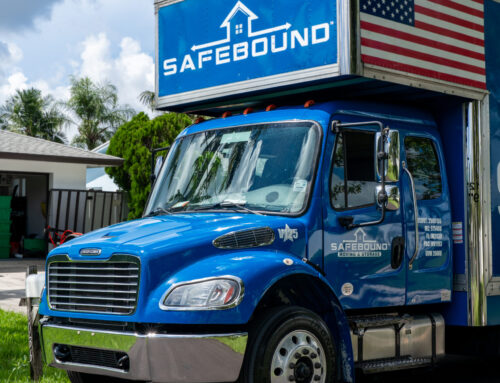Let’s be honest—moving with pets is stressful. Your dog senses something’s up the moment you pull out the first box. Your cat has already claimed a spot under the bed and refuses to come out. And don’t even get us started on trying to explain to your parrot why their favorite perch is suddenly wrapped in bubble wrap.
But here’s the thing: moving with pets doesn’t have to be a total nightmare. We’ve helped thousands of families move with their furry (and feathered, and scaled) friends, and we’ve learned what actually works when moving with pets. Not the Pinterest-perfect advice that nobody follows—real, practical tips that’ll keep both you and your pets sane during the move.
Essential Pre-Move Planning for Moving with Pets
1. Visit Your Vet Way Earlier Than You Think When Moving with Pets
Don’t wait until the week before your move. Book that vet appointment 4-6 weeks out. You’ll need updated vaccinations, a health certificate if you’re crossing state lines, and copies of all medical records. Plus, this is your chance to ask about calming medications or supplements if your pet freaks out in the car.
Pro tip: Some states have weird pet rules you’ve never heard of. Hawaii has a quarantine. California has specific requirements for certain breeds. Google your destination state’s pet laws before you’re frantically googling them from a rest stop at 2am.
2. Update Pet ID Before Moving with Pets
Murphy’s Law says your pet will escape exactly when you least expect it during a move. Update their microchip info with your new address and get new ID tags with your cell number. Take some clear photos of your pet too—you know, just in case. Nobody wants to think about it, but better safe than sorry when moving with pets.
3. Research Your New Area’s Pet Policies
Is your new apartment complex one of those places with a three-page pet policy? Does your HOA ban pit bulls? (Seriously, some places still do this.) Figure this stuff out now, not when you’re signing the lease. Also, find the nearest emergency vet—because of course someone’s going to eat something weird on day one.
4. Maintain Their Routine While Moving with Pets
Your routine is about to get wrecked, but your pet’s doesn’t have to be. Feed them at the same time. Walk the dog at the same time. Keep their favorite blanket out even when everything else is packed. Set up a corner of your house as a “pet sanctuary” away from the packing chaos where they can just… exist without freaking out.
5. Introduce Moving Supplies Gradually
Most pets are naturally curious (okay, nosy). Let them sniff the boxes. Your cat will probably claim at least three as new sleeping spots. That’s fine—it helps them get used to all the weird new stuff in their space. And for the love of all that is good, introduce the pet carrier early when moving with pets. Not the morning of the move. Give them a few weeks to decide it’s not a torture device.
6. Consider Anxiety Relief for Moving with Pets
Some pets handle change like champs. Others… don’t. If your dog loses it every time someone rings the doorbell, or your cat hides for three days when you rearrange the furniture, talk to your vet about options for moving with pets. There are prescription meds, natural supplements, and those pheromone diffusers (Feliway for cats, Adaptil for dogs). They’re not magic, but they help.
Moving Day: Critical Steps for Moving with Pets
7. Create a Safe Space on Moving Day
This is non-negotiable when moving with pets. On moving day, your pets need to be in a closed room—ideally with a bathroom and a big “PETS INSIDE – DO NOT OPEN” sign on the door. Include their water, food, favorite toys, and for cats, their litter box. Yes, movers are professionals, but doors get left open. It happens. Don’t risk it.
If your pet is the nervous type or prone to bolting, honestly? Pay for doggy daycare or boarding for the day. It’s worth every penny for your peace of mind.
8. Safe Transportation When Moving with Pets
We’ve heard the horror stories about pets in moving trucks. Don’t do it. Your pet rides with you, secured in a carrier or with a pet seatbelt. Pack their stuff in an easily accessible bag—food, bowls, leash, poop bags, any meds. Stop every couple hours for bathroom breaks and water when moving with pets long distances.
And this should go without saying, but never leave them in a parked car. Not even “just for a minute.” Not even with the windows cracked. Just… don’t.
9. Air Travel Considerations for Moving with Pets
If you’re flying when moving with pets, the rules are all over the place depending on the airline. Some let small pets in the cabin. Larger dogs might have to fly cargo, which stresses everyone out. Book direct flights when possible—nobody wants their pet stuck in Dallas during a layover. And get them used to that airline-approved carrier beforehand, not the night before at 11pm when you realize they don’t fit.
Moving with Dogs: Breed-Specific Relocation Tips
10. Tailor Your Approach for Different Dog Breeds
Your high-energy lab needs to be thoroughly exhausted before the move. Like, multiple-walks-and-a-trip-to-the-dog-park exhausted. Anxious rescue dogs might need extra reassurance or a professional pet sitter for moving day. Senior dogs? Keep everything as routine as humanly possible when moving with pets in their golden years, and make sure their joint meds are easy to access.
11. Exercise and Territory Building When Moving with Dogs
Maintain regular walks and exercise throughout the move. Let them say goodbye to their favorite spots—it sounds silly, but dogs know their territory. Once you’re at the new place, walk the same route a few times so they can start marking their new territory. Dogs are all about territory, especially when moving with pets to unfamiliar areas.
Moving with Cats: Feline-Specific Moving Strategies
12. Understanding Cat Territoriality When Moving with Pets
Moving with cats is different because cats bond with places, not just people. They’re going to be upset. Set up one room in your new home first—just for them—with all their familiar stuff. Use those Feliway diffusers in both the old and new place. And whatever you do, don’t wash their bedding before the move when moving with pets. They need those familiar smells.
Keep them in that one room for the first few days, then slowly let them explore the rest of the house. It’s like introducing them to a new pet, except the new pet is your entire house.
13. Prevent Cat Escapes When Moving with Pets
Cats will absolutely try to escape when they’re stressed. Check every window screen, every door, every possible escape route before you let them out of their carrier. Keep cats indoors for at least two to three weeks after moving with pets to a new location, even if they’re usually indoor-outdoor cats. A freaked-out cat in an unfamiliar neighborhood is a recipe for disaster.
Moving with Exotic Pets: Special Requirements
14. Relocating Birds, Reptiles, and Small Animals
Birds are drama queens about change when moving with pets. Keep them in their regular cage with their favorite toys, cover it during transport (but make sure there’s airflow), and keep talking to them so they know you’re still there. Temperature matters—keep it between 65-80°F.
Reptiles need critical temperature control when moving with pets. Never, ever put them in the moving truck. They ride with you in a secure container with proper heating or cooling. Set up their habitat the second you get to the new place.
Small mammals like rabbits and guinea pigs need secure carriers (not their regular cages which can break in a car) and lots of water-rich veggies for hydration during the trip.
Fish are honestly the worst to move. Short distance? Sealed bags with oxygen. Long distance when moving with pets? You might want to find them a new home and start fresh with new fish at your destination. Your aquarium should never be moved with water and fish in it—that’s a disaster waiting to happen.
15. First Week After Moving with Pets: Settlement Tips
Unpack their stuff first when moving with pets to a new home. Before your dishes, before your clothes, before anything else. Get their feeding station set up, their bed in place, their toys out. Keep feeding times exactly the same as before.
Dogs need to walk the same route multiple times to figure out “this is my street now.” Create a designated safe spot in the new house where they can retreat when overwhelmed.
Cats need time. Keep them in that one room with everything they need for a few days. Then open the door and let them explore at their own pace. Don’t chase them out or force them to socialize. They’ll come around.
Common Behavioral Challenges When Moving with Pets
Even if you do everything right when moving with pets, expect some weird behavior. Dogs might bark more, chew things they normally wouldn’t, or have accidents despite being fully housetrained. Cats might hide for days, refuse food, or pee outside the litter box. It’s stress, not them being bad pets.
Most of this resolves in two to three weeks after moving with pets. If it doesn’t, or if they’re showing physical symptoms like vomiting or lethargy, call your new vet.
Stick to routines like your life depends on it. Don’t punish stress behaviors—that makes it worse. Just be patient and give lots of positive reinforcement when they do adjust.
Florida-Specific Tips for Moving with Pets
Moving with pets to or within Florida? The heat is no joke. Never leave pets in the car, walk dogs in the early morning or evening when the pavement won’t burn their paws, and watch for heat exhaustion.
Also, Florida has some legitimately scary wildlife. Alligators live in random ponds and lakes—keep dogs leashed near any water. There are venomous snakes. Cane toads are toxic if your dog licks or bites them. Fire ants are vicious. Teaching a solid “leave it” command is essential down here when moving with pets to Florida.
You’ll need year-round flea, tick, and heartworm prevention. This isn’t optional in Florida’s climate—mosquitoes are constant and heartworm is everywhere.
And heads up: many Florida HOAs have intense pet policies. Some ban certain breeds entirely. Figure this out before you fall in love with a house. Learn more about moving to Florida with our specialized services.
Your Moving with Pets Timeline
6-8 weeks out: Vet appointment, research new area’s pet rules, update microchip, find new vet, start carrier training.
2-4 weeks out: Order new ID tags, get health certificates, refill medications, book pet-friendly hotels if needed.
1 week out: Pack their travel bag, create safe space for moving day, take updated photos.
Moving day: Light breakfast for pets, secure them away from movers, keep their supplies accessible, transport them yourself.
First week: Unpack pet stuff first, maintain exact same schedule, pet-proof the new place, register with new vet.
Making Moving with Pets Work for Your Family
Moving with pets is extra work. There’s no way around it. But these strategies—the ones that actually get used, not the theoretical perfect plans—will make moving with pets manageable for everyone involved.
At Safebound Moving, we get it because we’re pet owners too. We’ve moved with dogs who bark at everything, cats who hate everyone, and that one customer’s very judgmental parrot. Our crews know to work around your pets carefully and respect their space when moving with pets.
Planning your move? Contact us and mention you’ve got pets. We’ll make sure the plan works for your whole family—yes, including the ones with four legs, scales, or wings.
Check out our blog for more realistic moving advice including packing tips and timing your move.
External Resources:




